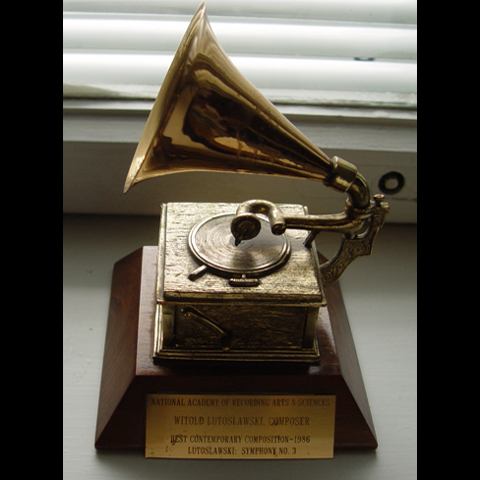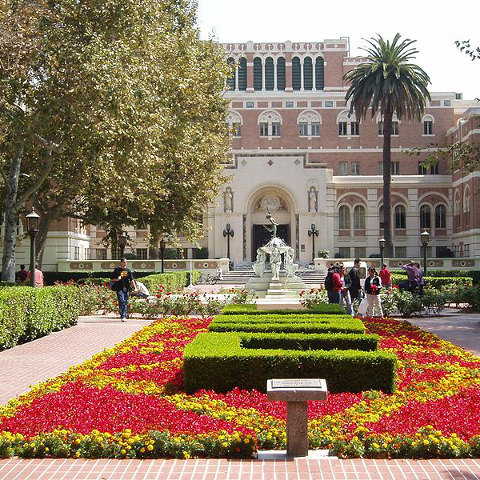Composers / Witold Lutosławski / Places catalog
Los Angeles
Danuta and Witold Lutosławski made their first visit to Los Angeles in 1962, as part of a ‘goodwill tour’ organised by the Department of State. Ten years later, Zubin Mehta, head of the Los Angeles Philharmonic at the time, proposed that Lutosławski compose a work for his orchestra. The composer began work on the score, which he entitled ‘A maiori’, short for ‘a maiori ad minus’, and so (to argue) from something bigger to something smaller. After two years, however, the sketches ended up on the shelf, and in any case the orchestra did not press him about the work, since it had fallen into financial difficulties. Another decade passed, and Los Angeles became something of a permanent address for Lutosławski on the west coast. From 1983, the LA Philharmonic programmed his works almost every year, inviting him to conduct monographic concerts as many as five times.
Lutosławski’s first direct contact with a Los Angeles audience came in 1983, during the CalArtsContemporary Music Festival. There, he conducted a number of works, including the Cello Concerto, which he would conduct twice more in Los Angeles over subsequent years, always with Lynn Harrell.
In November 1984, Lutosławski travelled to Los Angeles again, this time invited by the School of Music of the University of Southern California and by Stefan and Wanda Wilk. The Wilks had contacted Lutosławski a few years earlier, asking if he might donate some manuscripts and help them set up a centre promoting Polish music on the US west coast. The Polish Music Reference Center, founded under the aegis of the USC, was opened in January 1985. The ceremony took place in the Doheny Library – one of the university’s central buildings, in the presence of the founders, the university authorities and the composer, who donated five manuscripts of his works: the Mini-overture, Preludes and Fugue for thirteen string instruments, Mi-parti, Novelette and Paroles tissées. In May 2001, thanks to the efforts of Maya Trochimczyk, Józef Patkowski bolstered that collection with a handwritten copy of the score of Trois poèmes d’Henri Michaux.
During his stay there in 1983, Lutosławski spent many days taking lessons with the students and rehearsals with the university orchestra, as well as giving interviews and taking part in concerts with his music.
Also at that time, Esa-Pekka Salonen, the orchestra’s new musical director, made his debut with the Los Angeles Philharmonic with the first west coast performance of Lutosławski’s Third Symphony. A recording of that performance subsequently won as many as four prizes: a Grammy, the Cecilia Prize, the Koussevitzky Award and a Gramophone Award. Salonen, who had met Lutosławski during his studies in Helsinki in the seventies, very often included his music on the programmes of his concerts and recorded them onto disc. With the Los Angeles Philharmonic, he recorded the Fourth Symphony (twice), the Second Symphony, Les espaces du sommeil (with the baritone John Shirley-Quirk), the Piano Concerto (with Paul Crossley) and Chantefleurs et Chantefables (with Dawn Upshaw). Salonen was helped in his promotion of Lutosławski in Los Angeles by the orchestra’s artistic director, the composer and Cornell University professor Steven Stucky, known as the author of a monograph on Lutosławski’s music.
In 1988, the LA Philharmonic again approached Lutosławski about writing a new work. That situation was witnessed by Steven Stucky: ‘it was over lunch at a restaurant called Scandia, in West Hollywood, now closed. Present were Witold, executive director Ernest Fleischmann, and I. Ernest said, “We’d be honored if you would write us a new symphony.” Witold gave a very characteristic reply: he was flattered by the request, he said, but he never accepted deadlines, advance fees, or other encumbrances. He did not want a contract until and unless the piece were written, because everything would depend on whether the right idea came alone. He would let us know if anything occurred to him. Well, knowing that his Third Symphony, commissioned by the Chicago Symphony, had required an 11-year gestation period, we resigned ourselves to waiting, perhaps for many years, for a symphony that might or might not ever be written. Imagine our surprise 3 years later when Witold ran into LA Philharmonic Music Director Esa-Pekka Salonen in Europe and said something like, “By the way, your new symphony is ready.” Nothing had ever been said about money; there was no contract; what mattered was the music.’ The performance of the Fourth Symphony was given less than two weeks after Lutosławski’s eightieth birthday, on 5 February 1993.
In that same year, the orchestra was celebrating its seventy-fifth anniversary, and so it invited several composers, including Lutosławski, to compose short occasional works to mark the occasion. Thus arose the Fanfare for Los Angeles Philharmonic – Witold Lutosławski’s last completed score. That piece was first performed on 4 November 1993, with the Los Angeles Philharmonic led by the Austrian conductor Franz Welser-Möst. On the disc recording made the following year, the LA orchestra was conducted by Salonen.
The cover of the disc featuring the Fourth Symphony that was released after the composer’s death features a photograph taken in circumstances which Esa-Pekka Salonen remembers very well ‘It was in 1989. A press conference was held in relation to my appointment as Principal Conductor of the LA Philharmonic. It just so happened that Lutosławski was in Los Angeles at the time, working on his compositions with a student orchestra. He came to the conference, which for me was like salvation, because I didn’t know anyone there. It was all very American: television cameras, journalists, a lot of noise and commotion, and amidst it all was I, an ordinary boy from Finland, completely inexperienced and not knowing how to move in such a world. Witold supported me a great deal. The photograph was taken at the moment when we spotted each other at the reception that preceded the conference. It’s clear from the look on my face how happy I was to see him’.
-

Grammophone Award for The Third Symphony (1986). The Witold Lutosławski Society.
-

The Walt Disney Concert Hall, home to the Los Angeles Philharmonic. Phot. Carol M. Highsmith.
-

University of Southern California. (creative commons)
-
_fot._betty_freeman_be&w.jpg)
Witold Lutosławski and Simon Rattle, Los Angeles, 31.I.1993. Phot. Betty Freeman/BE&W
-
_fot._betty_freeman_be&w.jpg)
Witold Lutosławski with Lynn Harrell, 9.VIII.1989. Phot. Betty Freeman/BE&W